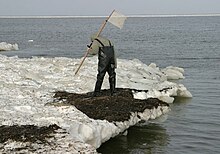Baltic amber


The Baltic region is home to the largest known deposit of amber, called Baltic amber or succinite. It dates from 44 million years ago (during the Eocene epoch).[1] It has been estimated that these forests created more than 100,000 tons of amber.[2] Today, more than 90% of the world's amber comes from Kaliningrad Oblast of Russia. It is a major source of income for the region; the local Kaliningrad Amber Combine extracted 250 tonnes of it in 2014,[3] 400 tonnes in 2015.[4]
The term "Baltic amber" is generic, so amber from the Bitterfeld brown coal mines in Saxony (Eastern Germany) sometimes is included the same name. Bitterfeld amber was previously believed to be only 20–22 million years old (Miocene), but a comparison of the animal inclusions revealed that it is most probably genuine Baltic amber that has only been redeposited in a Miocene deposit.[5] Other sources of Baltic amber have been listed as coming from Poland and Russia.
Because Baltic amber contains about 8% succinic acid, it is also termed succinite.
Baltic amber tree
It was thought since the 1850s that the resin that became amber was produced by the tree Pinites succinifer, but research in the 1980s came to the conclusion that the resin originates from several species. More recently, it has been proposed, on the evidence of Fourier-transform infrared microspectroscopy (FTIR) analysis of amber and resin from living trees, that conifers of the family Sciadopityaceae were responsible.[2] The only extant representative of this family is the Japanese umbrella pine, Sciadopitys verticillata.
Structure

The structure of Baltic amber (succinite) is complex. It is not a polymer, because it is not composed of a repeating pattern of «mers» of the same type. Rather it has a macromolecular structure arranged in a crosslinked network, in which the pores (free spaces) are filled by components of molecular structure (e.g. by mono- and sesquiterpenes). Thus the chemical structure of the amber may be described as a supramolecule.[6] The structure makes the amber denser, harder and more resistant to external factors. It make also possible a good preservation of plant and animal inclusions.[7]
Paleobiology

Numerous extinct genera and species of plants and animals have been discovered and scientifically described from inclusions in Baltic amber.[8] Inclusions of insects make up over 98% of the animals preserved in the amber, while all other arthropods, annelids, molluscs, nematodes, protozoans contribute less than 0.5% of the animals. Vertebrates are another 0.5% of the animals included and mostly are represented by mammal fur, feathers, and reptiles.[9]

Flora
| Name | Authors | Year | Family | Notes | Images |
|---|---|---|---|---|---|
|
Heinrichs et al |
2015 |
||||
|
Heinrichs et al |
2014 |
Fauna
Column-generating template families
The templates listed here are not interchangeable. For example, using {{col-float}} with {{col-end}} instead of {{col-float-end}} would leave a <div>...</div> open, potentially harming any subsequent formatting.
| Type | Family | Handles wiki
table code?† |
Responsive/ mobile suited |
Start template | Column divider | End template |
|---|---|---|---|---|---|---|
| Float | "col-float" | Yes | Yes | {{col-float}} | {{col-float-break}} | {{col-float-end}} |
| "columns-start" | Yes | Yes | {{columns-start}} | {{column}} | {{columns-end}} | |
| Columns | "div col" | Yes | Yes | {{div col}} | – | {{div col end}} |
| "columns-list" | No | Yes | {{columns-list}} (wraps div col) | – | – | |
| Flexbox | "flex columns" | No | Yes | {{flex columns}} | – | – |
| Table | "col" | Yes | No | {{col-begin}}, {{col-begin-fixed}} or {{col-begin-small}} |
{{col-break}} or {{col-2}} .. {{col-5}} |
{{col-end}} |
† Can template handle the basic wiki markup {| | || |- |} used to create tables? If not, special templates that produce these elements (such as {{(!}}, {{!}}, {{!!}}, {{!-}}, {{!)}})—or HTML tags (<table>...</table>, <tr>...</tr>, etc.)—need to be used instead.
See also
References
- ^ Ritzkowski, S. (1997). "K-Ar-Altersbestimmungen der Bernsteinführenden Sedimente des Samlandes (Paläogen, Bezirk Kaliningrad)". Metalla. 66 (Sonderheft). Bochum: 19–23.
- ^ a b Wolfe, A. P.; Tappert, R.; Muehlenbachs, K.; Boudreau, M.; McKellar, R. C.; Basinger, J. F.; Garrett, A. (2009). "A new proposal concerning the botanical origin of Baltic amber". Proceedings of the Royal Society B. 276 (1672): 3403–3412. doi:10.1098/rspb.2009.0806. PMC 2817186. PMID 19570786.
- ^ "Russia: Amber covers beach after storm". BBC. 9 January 2015.
- ^ "Amber mining". Amber Museum Kaliningrad.
- ^ Dunlop, J. A.; Giribet, G. (2003). "The first Fossil Cyphophthalmid (Arachnida: Opiliones), from Bitterfeld Amber, Germany". Journal of Arachnology. 31 (3): 371–378. doi:10.1636/h03-03.
- ^ Matuszewska A. Bursztyn (sukcynit), inne żywice kopalne, subfosylne I współczesne. Katowice, 2010.
- ^ Matushevskaya 2013, p. 8
- ^ Weitschat, W.; Wichard, W. (2002). Atlas of Plants and Animals in Baltic Amber. Pfeil. ISBN 978-3931516949.
- ^ Weitschat, W.; Wichard, W. (2010). "Chapter 6: Baltic amber". In Penney, D. (ed.). Biodiversity of Fossils in Amber from the Major World Deposits. Siri Scientific Press. pp. 80–115. ISBN 978-0-9558636-4-6.
- ^ Heinrichs, J; Schmidt, AR; Schäfer-Verwimp, A; Gröhn, C; Renner, MAM (2015). "The leafy liverwort Notoscyphus balticus sp. nov. (Jungermanniales) in Eocene Baltic amber". Review of Palaeobotany and Palynology. 217: 39–44. doi:10.1016/j.revpalbo.2015.02.006.
- ^ Heinrichs, J; Hedenäs, L; Schäfer-Verwimp, A; Feldberg, K; Schmidt, AR (2014). "An in situ preserved moss community in Eocene Baltic amber". Review of Palaeobotany and Palynology. 210: 113–118. doi:10.1016/j.revpalbo.2014.08.005.
Bibliography
Matushevskaya, Aniela (2013). "Natural and artificial resins – chosen aspects of structure and properties" [Натуральные и искусственные смолы – некоторые аспекты структуры и свойств]. In Kostjashova, Z. V. (ed.). Янтарь и его имитации Материалы международной научно-практической конференции 27 июня 2013 года [Amber and its imitations] (in Russian). Kaliningrad: Kaliningrad Amber Museum, Ministry of Culture (Kaliningrad region, Russia). p. 113. ISBN 978-5-903920-26-6. {{cite book}}: Cite has empty unknown parameters: |nopp= and |dead-url= (help); Invalid |ref=harv (help); Invalid |script-title=: missing prefix (help)
